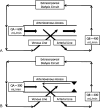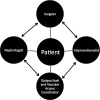Surveillance of hemodialysis vascular access
- PMID: 21326504
- PMCID: PMC3036423
- DOI: 10.1055/s-0029-1222457
Surveillance of hemodialysis vascular access
Abstract
A mature, functional arteriovenous (AV) access is the lifeline for a hemodialysis (HD) patient as it provides sufficient enough blood flow for adequate dialysis. As the chronic kidney disease (CKD) and end-stage renal disease (ESRD) population is expanding, and because of the well-recognized hazardous complications of dialysis catheters, the projected placement and use of AV accesses for HD is on the rise. Although a superior access than catheters, AV accesses are not without complications. The primary complication that causes AV accesses to fail is stenosis with subsequent thrombosis. Surveying for stenosis can be performed in a variety of ways. Clinical monitoring, measuring flow, determining pressure, and measuring recirculation are all methods that show promise. In addition, stenosis can be directly visualized, through noninvasive techniques such as color duplex imaging, or through minimally invasive venography. Each method of screening has its advantages and disadvantages, and several studies exist which attempt to answer the question of which test is the most useful. Ultimately, to maintain the functionality of the access for the HD patient, a team approach becomes imperative. The collaboration and cooperation of the patient, nephrologist, dialysis nurse and technician, vascular access coordinator, interventionalist, and vascular surgeon is necessary to preserve this lifeline.
Keywords: Hemodialysis; arteriovenous fistula; arteriovenous graft; surveillance; vascular access.
Figures





Similar articles
-
[Access for starting kidney replacement therapy: vascular and peritoneal temporal access in pre-dialysis].Nefrologia. 2008;28 Suppl 3:105-12. Nefrologia. 2008. PMID: 19018747 Spanish.
-
Pre Dialysis care and types of Vascular Access Employed in Incident Hemodialysis Patients: A study from Pakistan.Pak J Med Sci. 2013 May;29(3):828-31. doi: 10.12669/pjms.293.3385. Pak J Med Sci. 2013. PMID: 24353637 Free PMC article.
-
A Multicenter Randomized Clinical Trial of Hemodialysis Access Blood Flow Surveillance Compared to Standard of Care: The Hemodialysis Access Surveillance Evaluation (HASE) Study.Kidney Int Rep. 2020 Aug 4;5(11):1937-1944. doi: 10.1016/j.ekir.2020.07.034. eCollection 2020 Nov. Kidney Int Rep. 2020. PMID: 33163714 Free PMC article.
-
Maintaining vascular access: the management of hemodialysis arteriovenous grafts.J Vasc Access. 2010 Apr-Jun;11(2):92-9. doi: 10.1177/112972981001100202. J Vasc Access. 2010. PMID: 20155717 Review.
-
Vascular access as a determinant of adequacy of dialysis.Semin Nephrol. 2005 Mar;25(2):96-101. doi: 10.1016/j.semnephrol.2004.09.016. Semin Nephrol. 2005. PMID: 15791561 Review.
Cited by
-
A shear gradient-activated microfluidic device for automated monitoring of whole blood haemostasis and platelet function.Nat Commun. 2016 Jan 6;7:10176. doi: 10.1038/ncomms10176. Nat Commun. 2016. PMID: 26733371 Free PMC article.
-
Does regular surveillance improve the long-term survival of arteriovenous fistulas?Int J Nephrol. 2012;2012:539608. doi: 10.1155/2012/539608. Epub 2011 Dec 1. Int J Nephrol. 2012. PMID: 22187644 Free PMC article.
-
Mathematical Models for Blood Flow Quantification in Dialysis Access Using Angiography: A Comparative Study.Diagnostics (Basel). 2021 Sep 26;11(10):1771. doi: 10.3390/diagnostics11101771. Diagnostics (Basel). 2021. PMID: 34679469 Free PMC article.
-
Monitoring and Surveillance of Hemodialysis Access.Semin Intervent Radiol. 2016 Mar;33(1):25-30. doi: 10.1055/s-0036-1572548. Semin Intervent Radiol. 2016. PMID: 27013773 Free PMC article. Review.
-
A pilot study on adjunctive use of parametric colour-coded digital subtraction angiography in endovascular interventions of haemodialysis access.BMC Med Imaging. 2018 Sep 15;18(1):28. doi: 10.1186/s12880-018-0270-8. BMC Med Imaging. 2018. PMID: 30219054 Free PMC article.
References
-
- United States Renal Data System 2007 Annual Data Report. Bethesda, MD: U.S. Department of Health and Human Services, Public Health Service, National Institutes of Health; 2007.
-
- Astor B C, Eustace J A, Powe N R, Klag M J, Fink N E, Coresh J, CHOICE Study Type of vascular access and survival among incident hemodialysis patients: the Choices for Healthy Outcomes in Caring for ESRD (CHOICE) Study. J Am Soc Nephrol. 2005;16(5):1449–1455. - PubMed
-
- Lee T, Barker J, Allon M. Tunneled catheters in hemodialysis patients: reasons and subsequent outcomes. Am J Kidney Dis. 2005;46(3):501–508. - PubMed
-
- Maya I D, Oser R, Saddekni S, Barker J, Allon M. Vascular access stenosis: comparison of arteriovenous grafts and fistulas. Am J Kidney Dis. 2004;44(5):859–865. - PubMed
-
- Vascular Access 2006 Work Group Clinical practice guidelines for vascular access. Am J Kidney Dis. 2006;48(Suppl 1):S176–S247. - PubMed
LinkOut - more resources
Full Text Sources
Other Literature Sources
Medical
Research Materials

